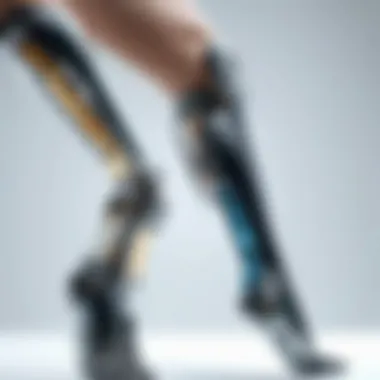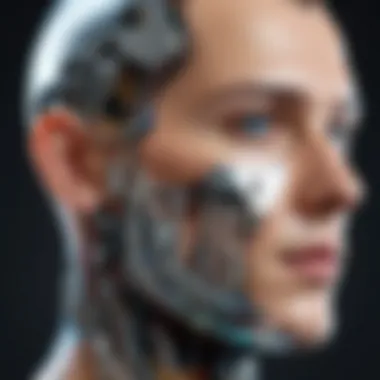The Evolution and Cultural Impact of Prosthetics


Intro
The development of prosthetics has come a long way in recent years. Historical designs have evolved from basic wooden models to complex bionic systems that can interact with users' nervous systems. This transformation reflects not only technological advancements but also shifts in societal attitudes towards disability and identity. Understanding this evolution is essential for recognizing the profound impact prosthetic devices have had on individual lives and culture as a whole.
Technology Insights
Latest Tech Trends
Prosthetics are now at the forefront of medical technology. Current trends show a strong emphasis on integrating artificial intelligence and robotics into prosthetic limbs. Companies like Össur and Integrum are leading the charge in creating systems that adapt to various environments and user needs. These advances allow users to regain not only mobility but also functionality that mirrors natural movement.
Innovation in Tech
The recent innovations include sensors that provide real-time feedback, allowing users to adjust their movements seamlessly. For example, the development of the i-limb Quantum prosthetic hand includes individual motorized fingers that work with the user’s muscle signals for a more intuitive experience. Such innovations lead to improved quality of life and a stronger sense of independence for many.
"Innovation in prosthetics is reshaping what it means to live with a disability. It's empowering individuals to redefine their limits."
Product Reviews
Evaluating these products reveals both strengths and limitations. The C-Leg by Ottobock, for instance, offers stability and intuitive movement, making it a favorite among amputees. However, the cost and accessibility continue to be significant barriers for many potential users. While advancements are impressive, they must be balanced with considerations of affordability and availability.
Societal Implications
The societal impact of prosthetics extends beyond individual users. It influences perceptions of disability within communities. As prosthetics become more advanced, they challenge traditional notions of what constitutes ability. This shift can lead to increased inclusivity in various aspects of life, including work and social engagement.
Future Prospects
Looking ahead, the future of prosthetics appears promising. Advancements in materials such as carbon fiber and smart polymers are paving the way for lighter and more durable devices. Furthermore, the exploration of brain-computer interfaces could lead to prosthetics that users control directly with their thoughts. While such developments are still in early research phases, they signal a revolutionary step forward.
Historical Overview of Prosthetics
The history of prosthetics offers a vital perspective into human ingenuity and resilience. Understanding this historical journey sheds light on breakthroughs in medical science and the evolving perception of disability. Historical insights reveal how prosthetics have transformed from rudimentary devices to advanced technologies that significantly enhance quality of life. This section will explore the key milestones and the social context that shaped the development of prosthetic devices.
Ancient Prosthetic Devices
The concept of prosthetics is not new. Historical records indicate that ancient civilizations, such as the Egyptians and Romans, designed and utilized prosthetic devices. The first known prosthetic is the wooden toe found in a tomb in Egypt, dating back to 1000 B.C. This device was an early attempt to restore function and appearance for individuals who suffered limb loss.
In addition to the Egyptian toe, historical texts describe various forms of limb replacements made of wood, metal, and leather. The Romans developed a range of prosthetic tools, including the sophisticated wooden leg. These early devices were rudimentary, often lacking functionality but were crucial in demonstrating the human drive to adapt and overcome injuries.
Evolution Through the Ages
Throughout the Middle Ages, advancements in prosthetic design were sporadic. However, the Renaissance sparked a revival in technology and craftsmanship. The rise of anatomical studies led to a better understanding of the human body. This knowledge transitioned to the creation of more functional prosthetics.
By the 19th century, prosthetics began to reflect innovation in materials and mechanization. Designs began incorporating springs and pulleys. The advent of war also played a significant role in the evolution of prosthetics. With countless injuries from battles, there was an increased demand for functional limb replacements. The introduction of the first prosthetic limb with a mechanical knee, designed by a man named Ambroise Paré, stands as a pivotal moment in prosthetic history.
Modern Advances
Entering the 20th century, the field of prosthetics experienced exponential growth fueled by research and technological advancements. The introduction of lighter materials such as aluminum and plastics transformed both comfort and usability for users. Innovations continued with the incorporation of electronics that improved function and adaptability.
Today, bionic limbs represent the forefront of prosthetic technology. Devices such as the RHEO KNEE and LUKE Arm utilize advanced sensors and microprocessors to mimic natural movement, allowing users to perform daily tasks with greater ease. Moreover, the application of 3D printing technology has democratized access to prosthetics, making customization cheaper and more efficient.
As we look toward the future, understanding the historical context of prosthetics highlights the significant strides made. It also prompts critical questions regarding accessibility and societal perceptions surrounding disabilities.
"The story of prosthetics is a story of survival and adaptation. It reflects the intricate relationship between technology and humanity."
This narrative of progress is essential to grasp in order to appreciate the complexities of current prosthetic solutions and their impacts on users' lives. Predominantly, it presents a foundation for evaluating the future of prosthetic development.


Types of Prosthetics
Understanding the different types of prosthetics is essential because they cater to diverse needs and conditions. Each type offers specific benefits that can greatly enhance the lives of individuals with limb loss. The design of prosthetic devices has improved considerably, influenced by advancements in technology and materials. This progression not only addresses the physical requirements but also touches on psychological and social aspects, ensuring that users can engage fully with their environment.
Upper Extremity Prosthetics
Upper extremity prosthetics refer to devices designed for individuals who have lost their arms or parts of their arms. These prosthetics can range from simple cosmetic arms to sophisticated bionic devices. Such designs can restore partial or full functionality, allowing users to perform everyday activities like eating, writing, or working.
One significant aspect of upper extremity prosthetics is the control mechanisms. They can be categorized mainly into passive and active prosthetics. Passive devices primarily focus on appearance but do not enable movement. In contrast, active prosthetics can be operated through various means, like body movements or sensors, allowing for more natural interaction with the world.
Recent advancements include myoelectric prosthetics that utilize electrical signals from muscles to control the device. This raises the potential for users to have a more sensitive and intuitive interface, facilitating a better quality of life. However, these advancements often come at a higher cost, which can be a barrier to access for many.
Lower Extremity Prosthetics
Lower extremity prosthetics are crucial for individuals who have lost their legs or feet. These devices can significantly impact mobility and independence. From basic prosthetic feet to complex knee systems, the range is broad and tailored to various activity levels and lifestyle needs.
A key consideration in lower extremity prosthetics is the alignment and comfort of the device. A well-aligned prosthetic limb can reduce wear and tear on the residual limb, preventing discomfort or injury. Moreover, modern designs provide a level of customization, which is essential for matching the user's anatomy and needs.
One innovative area in lower extremity prosthetics is the use of hydraulic and pneumatic systems that enable better control of movement, especially in more challenging terrains. These prosthetics can adapt to walking speeds, allowing the user to maintain a natural gait. This improvement signifies a leap in both functionality and user experience.
Hybrid Prosthetic Systems
Hybrid prosthetic systems combine features of upper and lower extremity prosthetics to create versatile solutions for individuals with multi-limb loss. These systems often integrate unique technologies that enhance usability and allow for a smoother experience.
The development of hybrid systems addresses the complexities faced by users. These devices might feature advanced sensors that provide feedback to the user, helping them to navigate their environment more efficiently. Such reliance on technology showcases how modern prosthetics engage with the demands of daily living in a multifaceted way.
Hybrid prosthetics are not just tools; they represent a bridge between loss and capability, enhancing both independence and confidence.
The future of hybrid prosthetic systems remains bright as research progresses. Continuous innovation in materials and technology ensures that these devices will only improve, possibly integrating features like artificial intelligence which could revolutionize user interaction.
Technological Innovations in Prosthetics
Technological innovations have significantly transformed the landscape of prosthetics. These developments not only enhance the functionality of prosthetic devices but also cater to the specific needs of users. The advancements in materials, designs, and integrated technologies promote better integration with the human body, which enriches the overall user experience. As we delve into the various innovations, we will explore how they create more natural movements, improve accessibility, and eventually redefine the lives of those with limb loss.
Materials Used in Modern Prosthetics
Modern prosthetics employ materials that enhance performance and comfort. Traditionally, materials like wood and metal were used, but current advancements emphasize lightweight and durable materials.
- Carbon Fiber: Known for its tensile strength, carbon fiber is a preferred material in prosthetics. It offers resilience while being lightweight, which prevents fatigue during use.
- Titanium: This metal is favored for its biocompatibility and lightweight nature. It is especially useful in fittings and sockets.
- Silicone: Used for prosthetic liners, silicone provides comfort against the skin, reducing friction and enhancing fit.
- Smart Materials: Innovations in materials have led to the development of smart textiles that adjust to temperature or stress.
The choice of materials is critical, affecting both the functionality and the user’s quality of life with the device.
Bionic Technology and Its Applications
Bionic technology represents a leap forward in prosthetics. It uses advanced robotics and neural interfaces to create prosthetic limbs that mimic the natural functions of human limbs. Some key applications of bionic technology include:
- Control Systems: Bionic limbs can be controlled by the user’s muscle signals, allowing for more intuitive movements.
- Feedback Mechanisms: Advanced bionic devices can provide sensory feedback, which enables users to feel pressure or touch.
- Adaptive Learning: Machine learning algorithms can help prosthetic devices adapt to the user’s specific activities, improving efficiency over time.
Implementing bionic technology leads to a substantial increase in independence for users, which can dramatically enhance their daily lives.
3D Printing in Prosthetic Design
3D printing is revolutionizing the production of prosthetics, allowing for customization at an unprecedented scale. This technology provides several benefits:
- Customization: 3D printing enables the creation of tailored prosthetic devices that fit the unique anatomy of the user.
- Cost-Effectiveness: The production process can be less expensive, making prosthetics more affordable.
- Rapid Prototyping: Designers can quickly iterate on designs, leading to faster development and deployment of new prosthetic technologies.
- Accessibility: 3D printing allows for local production, reducing waiting times for users in remote areas.


This innovation not only meets diverse user needs but also democratizes access to prosthetic solutions across different socio-economic contexts.
"The evolution of technology in prosthetics mirrors the advancement of medicine itself, as both seek to restore function and improve quality of life."
These technological innovations are reshaping the landscape of prosthetics, promoting a future where individuals can engage more fully with their environments and enhance their quality of life.
The Role of Prosthetics in Rehabilitation
Prosthetics play a crucial role in the rehabilitation process for individuals who have lost limbs due to injury, disease, or congenital conditions. The integration of prosthetic devices not only restores physical mobility but also contributes significantly to the psychological and social rehabilitation of these individuals. Understanding how prosthetics facilitate rehabilitation can guide caregivers, medical professionals, and patients alike in maximizing their benefits.
Physical Rehabilitation Techniques
Physical rehabilitation techniques are essential for adapting to prosthetics. They include a variety of exercises tailored to improve strength, flexibility, and coordination. Physical therapists often create individualized plans for patients based on their unique needs and goals. For example:
- Strength Training: Building muscle strength around the residual limb ensures better control over the prosthetic device.
- Balance Exercises: Programs that focus on enhancing balance help patients regain stability while using their prosthesis.
- Gait Training: Specific techniques teach individuals how to walk again, utilizing the new limb effectively, ensuring a smoother transition from wheelchair or crutches.
These techniques not only aid in physical adjustment but also promote confidence, allowing individuals to engage in daily activities more freely.
Psychological Impact of Prosthetic Use
Prosthetic use significantly influences the psychological state of users. Adjusting to a new limb can be challenging, often leading to feelings of anxiety or inadequacy. It is vital to address psychological aspects during rehabilitation. Benefits of psychological support include:
- Improved Self-Image: Individuals often face social stigma associated with disabilities. Proactive mental health support can help improve their self-image and self-acceptance.
- Coping Mechanisms: Learning healthy ways to cope with the emotional fallout of limb loss can ease the adjustment process.
- Confidence Building: Group therapy sessions and counseling can foster a sense of community, sharing experiences among peers.
By acknowledging the psychological burden and providing appropriate support, rehabilitation can become a more holistic experience.
Integrating Prosthetics into Daily Life
The ultimate goal of rehabilitation with prosthetics is to allow individuals to reintegrate into their daily lives. This requires not only physical adaptation but also practical strategies for navigating everyday challenges. Key considerations include:
- Education and Training: Learning to use and maintain the prosthetic effectively can prevent frustration and enable autonomy.
- Ergonomic Assessments: Assessing home and work environments for accessibility can help adapt spaces to individual needs, promoting independence.
- Community Support: Building a strong support system within the community can facilitate easier transitions back to social activities and employment.
"The integration of prosthetics into daily life transforms not just mobility but also enhances one's sense of belonging and identity."
Societal Implications of Prosthetics
The societal implications of prosthetics extend beyond their mechanical design. They encompass the ways in which these devices impact human life, identity, and cultural perceptions of disability. Prosthetics are not merely tools for enhancing physical capability but are also embedded in social contexts. Understanding these implications is crucial to comprehending how advancements in prosthetic technology can influence individuals and communities.
Cultural Perceptions of Disability
Cultural views on disability vary significantly across societies. In some cultures, disabilities are seen as limitations, while others view them as facets of human diversity. Prosthetics can challenge negative perceptions by providing individuals with the means to engage more fully in societal activities. Improved visibility of individuals using prosthetics can shift perspectives towards acceptance and inclusion.
Historically, negative stereotypes often prevailed. However, as technology progressed, prosthetics became symbols of resilience and empowerment for many. The representation of prosthetic users in media and public life can play a significant role in reshaping these views. By highlighting achievements made possible through technology, society can recognize the potential that lies within every person, irrespective of physical challenges.
Prosthetics and Identity
The relationship between prosthetics and personal identity is complex. For many, prosthetics represent a reclaiming of agency. They allow individuals to redefine their capabilities and, in many cases, their place in society. Some users embrace their prosthetics as part of their identity. They might share their journey through social media or community groups, fostering connections with others who have similar experiences.
On the other hand, some may struggle with their identity in relation to their prosthetics. They may feel as though they are not entirely their authentic selves, especially at times when society views disability negatively. Supporting individuals in their journey of self-acceptance is essential, ensuring that their experiences with prosthetics contribute positively to their identity.
"Prosthetics can redefine not just mobility but the narrative of who we are as individuals and as a community."
Access and Equity in Prosthetic Care
Access to high-quality prosthetics is not universally available. Disparities exist based on factors such as geography, socioeconomic status, and healthcare systems. This inequality raises critical questions about justice and equity in healthcare.


Many individuals lack access to the latest technologies, particularly in low-income regions. Some may rely on outdated models, compromising their quality of life. Advocacy for equitable access is vital. This includes pushing for policies that ensure all individuals, regardless of their financial means, can benefit from advancements in prosthetic technology.
Additionally, public awareness campaigns can help to highlight these disparities, encouraging donations, scientific investments, and research aimed at creating affordable solutions. By promoting accessibility, society can ensure that prosthetics fulfill their purpose of enhancing autonomy and integration for all individuals.
Ethical Considerations in Prosthetic Development
Ethics in prosthetic development touches multiple facets of society. As technology improves and becomes more integrated into daily life, the ethical implications are increasingly complex. With advancements in biomechanics and robotics, designers, engineers, and healthcare providers face dilemmas that challenge conventional ethical frameworks. These considerations not only influence the designs of prosthetics but also affect the lives of users.
Ethical Challenges in Biomechanics
The field of biomechanics within prosthetics presents its own unique challenges. Designers must grapple with issues of safety, effectiveness, and individual needs. Prototypes and designs are tested rigorously, but real-world application can differ significantly. If a device fails or causes harm, the ethical responsibility falls heavily on the developer. There is also a growing concern about the rapid pace of innovation that sometimes outstrips proper research and user feedback.
In addition to safety, the accessibility of advanced prosthetic technology plays a crucial role in ethical discussions. Should advanced designs be exclusively available to those who can afford them? The disparities in healthcare access can lead to inequalities, which often leave lower-income individuals without the same opportunities as others.
Informed Consent Issues
Informed consent is critical in all areas of medicine, including prosthetics. Patients should fully understand the implications of utilizing a prosthetic device. This includes understanding the potential risks, benefits, and limitations of the device. However, in some situations, the complexity of technology can make this difficult. Many users may not possess the technical knowledge needed to make fully informed decisions.
Moreover, the ethical emphasis on informed consent raises questions surrounding coercion and pressure. For instance, patients may feel compelled to choose certain types of devices due to the influence of their healthcare providers or societal expectations. Ensuring genuine informed consent is not only a medical responsibility but also a critical ethical necessity in prosthetic development.
Data Privacy and Prosthetic Devices
With the rise of smart prosthetics that connect to devices and collect data, issues of privacy become increasingly pertinent. Automated systems gather user information to provide analytics and improve functionality. While this data can lead to better customization and performance, it also raises concerns about how this data is stored and who has access to it.
Protecting the privacy of users should be paramount in prosthetic development. Users must be educated on what data is being collected and how it will be used. Given the potential for sensitive information to be exposed, ensuring robust data protection measures and transparent practices is vital.
"The intersection of advanced technology and personal data privacy remains one of the most pressing ethical challenges in modern prosthetics."
As designers innovate, they will need to balance enhanced functionality with ethical data management practices.
In sum, ethical considerations in prosthetic development encompass an array of vital topics. As technology advances, recognizing and addressing these issues becomes integral to creating effective, fair, and safe prosthetic solutions.
Future Directions in Prosthetic Technology
The future of prosthetic technology presents a landscape filled with promise and potential. As innovations emerge, they not only enhance the functionality of prosthetic devices but also expand the boundaries of what is possible for individuals who rely on them. This section will explore key trends shaping the future of prosthetics, focusing on the emergence of next-generation materials, the integration of artificial intelligence, and the importance of collaborative design processes.
Next-Generation Materials and Designs
The evolution of materials used in prosthetics is critical to improving the user experience. Traditional materials have long dictated the limits of functionality and comfort. However, the advent of advanced composites and lightweight metals sharpens these boundaries. These materials are stronger, more flexible, and can be tailored to fit the unique anatomy of users.
Biomaterials, like those derived from natural origins, are gaining traction. They reduce the risk of rejection by the body and promote healing. Additionally, smart materials capable of adapting to environmental changes are on the horizon, potentially leading to prosthetics that adjust automatically for optimal performance.
In design, 3D printing also stands out. Designers can create bespoke fittings in a fraction of the time it once took. This can significantly reduce costs and make prosthetic devices more accessible.
Artificial Intelligence in Prosthetic Functionality
Artificial intelligence is reshaping the future of prosthetics in ways previously thought impossible. AI can enhance how prosthetics communicate with the nervous system, allowing for more intuitive control.
Through machine learning, these devices can learn a user’s movement patterns over time. This adaptation allows for better performance and comfort. For example, advanced sensors can detect movements and adjust the response in real-time. Users experience a more natural interaction between their limb and the prosthetic device.
Moreover, AI brings opportunities for remote monitoring. Healthcare professionals can track a user’s progress and make necessary adjustments without needing an in-person visit.
Collaborative Design Processes
The importance of collaboration in prosthetic design cannot be overstated. Engaging users in the design process leads to prosthetic devices that genuinely meet their needs. It also fosters a sense of ownership, which is crucial for user adaptability.
Involving multidisciplinary teams—engineers, medical professionals, and designers—ensures a comprehensive approach to development. Each perspective contributes to creating prosthetics that are functional, comfortable, and aesthetically pleasing.
Furthermore, user feedback mechanisms can be integrated post-deployment. Listening to user experiences provides valuable insights for future improvements.
"The growth in collaboration between users and designers is transformative. It reshapes how prosthetics are viewed—no longer as mere aids but as integrated parts of one’s body."
The trajectory of prosthetic technology reveals a future where comfort, functionality, and user experience converge uniquely. Ensuring that advancements prioritize user needs is key to fostering a more inclusive and effective prosthetic landscape.







